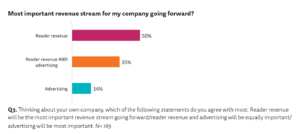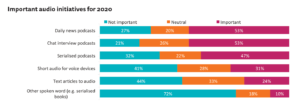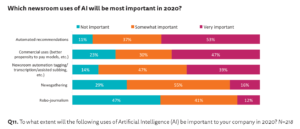What are the major media and technology trends, and how will they affect your own publishing business? RISJ (Reuters Institute for the Study of Journalism) have published their digital news predictions report, based on interviews with 200+ media CEOs, digital leaders and editors from across the world. In case you don’t have time to read it all, I have picked out four trends that are likely to impact all publishing businesses.
1. Reader revenue to become dominant source

Half of those surveyed believe that reader revenue will become their main revenue source. And another 35% believe that it will share that with advertising. Whilst the likes of the New York Times grab the headlines, there is evidence that digital subscriptions work for niche titles as well as large news media. Freemium and metered models seem equally popular. There is consensus that more engaged readers are more likely to subscribe, and a renewed focus on encouraging readers to register for (limited) free content.
An interesting development is the growing interest in finite editions, perhaps a reaction to the endless news feed. Readers seem to prefer a morning newsletter, a selection of the top stories or a digital edition.
Independent start-ups like DennikN in Slovakia, Follow the Money in the Netherlands and Zetland in Denmark are establishing sustainable subscription and membership models.
Publishers who are considering setting up a digital paywall need to work hard to integrate editorial, marketing, tech and commercial teams, as all must co-operate to be successful. The company needs a clear story, explaining what it stands for and how it serves its readers. And the digital user experience has to be up to high reader expectations.
2. Have to work harder to attract talent and new skills

Concern about attracting talent in digital disciplines like Product/UX, Technology and Data science is widespread among media leaders.
A more subtle issue is that people in their mid twenties to thirties (I’m trying to avoid the term “millennials”) have a different set of values to the previous generation. They are more loyal to themselves, their values and their career than they are to a media brand or a company. They may only expect to stay in a role for two or three years, and if they don’t get enough experience or development, they will leave.
So employers need to provide more coaching and regular feedback, and offer a wide range of projects and development opportunities, if they are to attract and retain this new generation.
Many media organisations are becoming more aware of their lack of diversity, both in terms of gender but also ethnic and social background. This is perhaps a more acute issue in national newsrooms, but all publishers can benefit from broadening the range of editorial voices.
3. Audio and podcasts will build engagement

Audio and podcasts content might be about to reach a tipping point. Well established in the US, and attracting a younger audience, podcasts are now on the agenda for news media worldwide.
RISJ identified 60 new daily news podcasts in 5 countries launching in the last couple of years. The challenge remains revenue generation, as advertising is still immature, but most media can see the value in building engagement with readers, and attracting a younger audience.
Danish slow news outlet Zetland publishes all its articles in audio form, and now 75% of stories are listened to rather than read. In Canada, the Globe and Mail is using Amazon Polly to convert text articles to audio (see also AI)
4. AI will help productivity, but not replace journalists

Artificial intelligence is worth monitoring, but more for generating automated content recommendations than creating articles. Schibsted is testing semi-automated front pages for titles like AftenPosten and VG.
AI has another application in automated language translation and subtitling, used for example by the BBC for its Japanese video service.
And some publishers are using AI in propensity modelling, to find out which online users might make the best subscription prospects.
Smaller media owners won’t have the resources to develop their own technology, but there are third party services emerging, such as Bibblio which supports smart content recommendations.
You can download the full RISJ report here:
Journalism, Media, and Technology Trends and Predictions 2020
If you’d like to discuss how these international trends should shape how you develop your own media business, do get in touch for a chat over a coffee.
About the author
Carolyn Morgan has bought, sold, launched and grown specialist media businesses across print, digital and live events. A founder of the Specialist Media Show (sold in 2014) she now advises media businesses large and small on their digital strategy through her consultancy Speciall Media.

